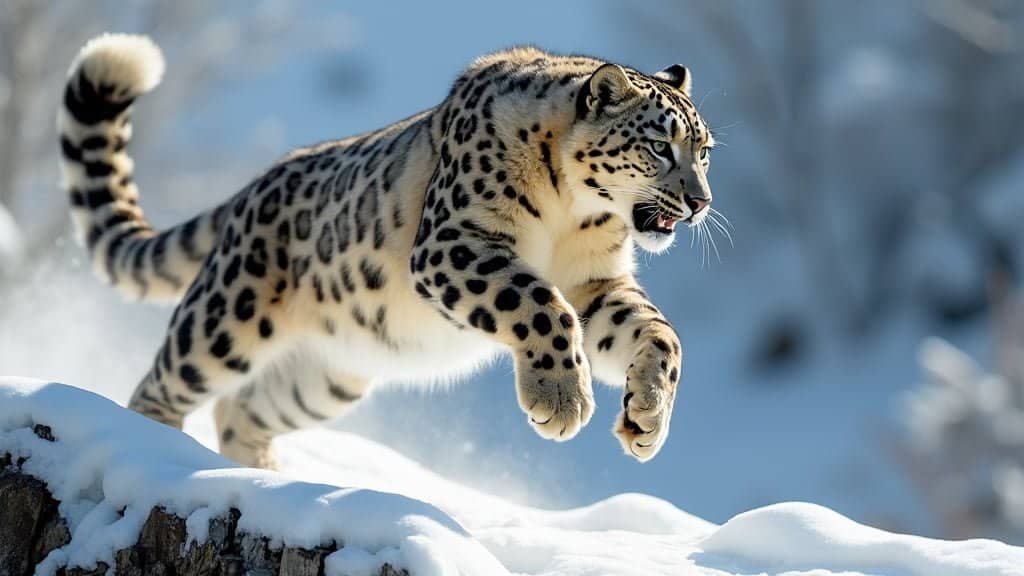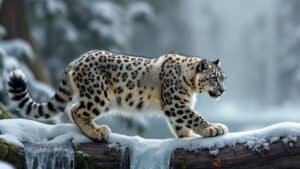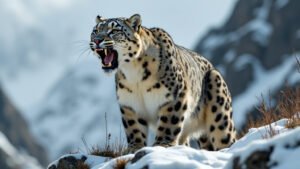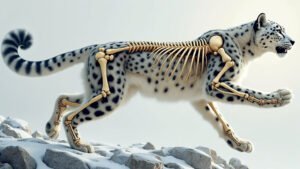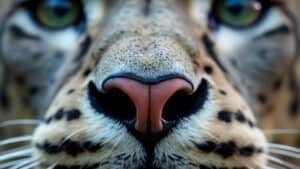Introduction
Snow leopards, known for their incredible agility and strength, are fascinating creatures that thrive in the rugged and high-altitude terrains of Central and South Asia. Their ability to execute powerful leaps is a testament to their unique muscular adaptations
In this article, we will explore the key muscles involved in a snow leopard’s leap, examine the role of muscle fiber types, and discuss how these cats have adapted to their challenging environments
Additionally, we will delve into muscle recovery mechanisms and the evolutionary benefits of these adaptations, providing a comprehensive understanding of how the snow leopard’s muscular system supports its remarkable leaping abilities
Key Muscles Involved in a Snow Leopard’s Leap
The snow leopard’s ability to leap across vast distances is supported by a combination of specialized muscles that provide both strength and agility. These muscular adaptations are crucial for their survival in the harsh, high-altitude environments they inhabit
Hind Leg Muscles and Their Role
The hind legs of a snow leopard are the primary powerhouses behind its incredible jumping ability. These legs are equipped with large, powerful muscles that can generate significant force. The main muscles involved are the quadriceps and the gluteus muscles
The quadriceps, located at the front of the thigh, are responsible for extending the knee and providing the thrust needed for a leap. The gluteus muscles, situated in the buttocks, are vital for hip extension and stabilization during the takeoff and landing phases of a jump
A study conducted by the Snow Leopard Trust revealed that the hind leg muscles of snow leopards are significantly more developed than those of other big cats, reflecting their need for powerful jumps to navigate their rocky, mountainous habitats (Snow Leopard Trust, 2018)
This muscular development allows snow leopards to leap distances of up to 50 feet horizontally, a necessary adaptation for chasing prey across rugged terrain
Importance of the Back Muscles
In addition to the hind legs, the back muscles of a snow leopard play a crucial role in its leaping ability
The spinal muscles, including the erector spinae and the multifidus, provide the necessary support and flexibility for powerful, coordinated movements. These muscles enable the snow leopard to arch and straighten its back, contributing to the force and control required for long-distance jumps
The flexibility and strength of the back muscles also allow snow leopards to twist and turn mid-air, an ability that is essential for adjusting their trajectory and ensuring a safe landing. This agility is particularly important when navigating the steep, uneven terrain of their natural habitat
Forelimb Function in Leaps and Landings
While the hind legs provide the primary propulsion for a leap, the forelimbs are essential for balance and landing
The forelimb muscles, including the biceps and triceps, as well as the muscles of the shoulder girdle, help absorb the impact of landing and stabilize the body. The strong pectoral muscles, in particular, play a significant role in controlling the descent and maintaining balance upon landing
The forelimbs also assist in the initial stages of a leap, providing additional lift and momentum. During a leap, the snow leopard extends its forelimbs forward, using the strength of the shoulder and chest muscles to maximize reach and stability
Muscle Fiber Types and Their Impact
The snow leopard’s powerful leaps are not just a result of their well-developed muscles but also the specific types of muscle fibers they possess
Understanding the different muscle fiber types and their distribution in the snow leopard’s body can shed light on how these majestic creatures achieve such remarkable athletic feats
Fast-Twitch vs Slow-Twitch Fibers
Muscle fibers are generally categorized into two main types: fast-twitch (Type II) and slow-twitch (Type I) fibers. Fast-twitch fibers are designed for quick, powerful bursts of movement but tire quickly
These fibers are crucial for activities that require speed and strength, such as leaping and sprinting. In contrast, slow-twitch fibers are more efficient at using oxygen to generate energy over longer periods, making them ideal for endurance activities
Snow leopards have a higher proportion of fast-twitch fibers, especially in their hind legs, which is a key factor in their ability to perform powerful leaps. The abundance of these fibers allows snow leopards to generate the rapid force needed to propel themselves across vast distances and steep inclines
Adaptations for Power and Endurance
While fast-twitch fibers dominate the muscle composition of snow leopards, they also possess a significant amount of slow-twitch fibers
This combination provides a balance of power and endurance, enabling them to maintain agility over prolonged periods and navigate their expansive, rugged territories efficiently
The distribution of these muscle fibers is strategic. The hind legs, which are responsible for the explosive power needed in leaps, contain a higher concentration of fast-twitch fibers
The back and core muscles, which contribute to stability and endurance, have a more balanced mix of both fiber types. This distribution ensures that snow leopards can sustain high levels of activity without rapid fatigue
Muscle Fiber Distribution in Snow Leopards
Research conducted by the Wildlife Conservation Society indicates that snow leopards’ muscle fiber distribution is uniquely adapted to their high-altitude environment (Wildlife Conservation Society, 2020)
The combination of fast-twitch and slow-twitch fibers in their muscle groups allows them to perform both explosive jumps and sustained chases, crucial for hunting in their mountainous habitats
The presence of slow-twitch fibers in the core and back muscles also aids in maintaining posture and balance during climbs and jumps, reducing the risk of injury. This balanced muscle composition is a result of evolutionary adaptations that have allowed snow leopards to thrive in some of the most challenging terrains on the planet
High-Altitude Muscle Adaptations
Snow leopards live in some of the harshest and most demanding environments on Earth, including the high-altitude regions of Central and South Asia. To thrive in these conditions, their muscular system has developed unique adaptations that allow them to perform optimally despite the challenges posed by thin air and cold temperatures
Oxygen Utilization Efficiency
One of the most significant challenges at high altitudes is the reduced availability of oxygen. Snow leopards have evolved to maximize their oxygen utilization efficiency, a crucial adaptation for maintaining muscle performance during intense physical activity
Their muscles contain a higher density of mitochondria, the powerhouses of cells, which enhance their ability to produce energy efficiently even with limited oxygen
Studies have shown that the myoglobin content in snow leopard muscles is higher than in many other large cats. Myoglobin is a protein that stores and transports oxygen within muscle cells, ensuring a steady supply during bursts of activity
This adaptation allows snow leopards to sustain their powerful leaps and high-energy pursuits without quickly depleting their oxygen reserves
Muscle Performance in Thin Air
The thin air at high altitudes means less oxygen is available for muscles during exertion
Snow leopards counter this by having a more developed capillary network within their muscles, which improves blood flow and oxygen delivery to muscle tissues. This dense capillary network ensures that muscles receive an adequate supply of oxygen, even during intense physical exertion
A study published in the Journal of Experimental Biology highlighted that snow leopards have adapted to their high-altitude environment through both physiological and anatomical changes
Their muscles are not only more efficient at using oxygen but also have a higher tolerance for low-oxygen conditions, allowing them to perform strenuous activities like leaping and chasing prey effectively (Journal of Experimental Biology, 2019)
Adaptations for Cold Environments
In addition to dealing with low oxygen levels, snow leopards must also cope with extremely cold temperatures
Their muscular system has adapted to generate and retain heat efficiently. The high density of mitochondria in their muscle cells not only aids in energy production but also generates heat as a byproduct, helping to maintain muscle function in freezing conditions
The snow leopard’s thick fur and subcutaneous fat provide insulation, but their muscular adaptations play a crucial role in thermoregulation as well
During physical activity, muscle contractions generate heat, which helps to keep their bodies warm. This is especially important when they are active during the colder parts of the day or night, which is often the case in their natural habitat
Muscle Recovery Post-Leap
Snow leopards rely heavily on their muscular system for survival, particularly their ability to make powerful leaps. However, repeated high-intensity activities necessitate efficient muscle recovery mechanisms to maintain their physical performance and overall health
Recovery Mechanisms
Muscle recovery in snow leopards involves several physiological processes that repair and rebuild muscle tissues after strenuous activity. These processes include protein synthesis, removal of metabolic waste products, and replenishment of energy stores. After a leap, muscle fibers can sustain microscopic damage, which triggers the body’s repair mechanisms to rebuild stronger muscle fibers
The presence of satellite cells, a type of stem cell located in muscle tissues, plays a crucial role in this repair process
When muscles are damaged, satellite cells activate, proliferate, and fuse with existing muscle fibers to promote healing and growth. This not only repairs the muscle damage but also increases muscle mass and strength over time
Nutrition and Muscle Health
Proper nutrition is vital for the muscle recovery process. In the wild, snow leopards’ diet primarily consists of meat from prey animals such as blue sheep and ibex
This diet is rich in proteins and essential amino acids, which are critical for muscle repair and growth. Proteins provide the building blocks for new muscle tissue, while fats and carbohydrates from their prey offer the necessary energy for metabolic processes
Hydration also plays an important role in muscle recovery. Snow leopards derive most of their water intake from their prey, which helps in the efficient removal of metabolic waste products like lactic acid that build up during intense physical activities. Proper hydration aids in maintaining optimal muscle function and reducing the risk of cramps and muscle fatigue
Impact of Repeated Leaping
Repeated leaping places significant demands on the snow leopard’s muscular system, making efficient recovery essential to prevent chronic fatigue and injury
Their bodies have adapted to manage the stress of repeated high-intensity activities. Enhanced blood circulation in their muscles ensures that nutrients and oxygen are delivered efficiently, promoting quicker recovery times
Moreover, snow leopards exhibit behaviors that facilitate muscle recovery. They often rest extensively between hunting sessions, allowing their muscles ample time to repair and strengthen. This rest period is crucial for preventing overexertion and ensuring that their muscles are ready for the next leap
Evolutionary Advantages of Muscular Adaptations
The muscular adaptations of snow leopards provide them with significant evolutionary advantages that enhance their survival and hunting efficiency in the harsh, high-altitude environments they inhabit
These adaptations have evolved over time to meet the specific demands of their environment, offering them a competitive edge
Survival in Rugged Terrain
Snow leopards live in some of the most challenging terrains, including rocky cliffs and steep, snow-covered mountains
Their muscular adaptations are perfectly suited for these environments, allowing them to navigate difficult landscapes with ease. The powerful muscles in their hind legs enable them to leap across wide gaps and ascend steep slopes, essential for moving through their rugged habitats
The flexibility and strength of their back muscles also play a critical role in maintaining balance and stability on uneven terrain. These adaptations help snow leopards avoid falls and injuries, which are vital for their survival in an environment where a misstep can be fatal
Predatory Efficiency
The muscular system of snow leopards is integral to their predatory efficiency. Their ability to execute powerful leaps allows them to ambush prey with precision and speed. The combination of strong hind leg muscles, flexible back muscles, and robust forelimbs enables them to pounce on prey from a distance, minimizing the chance of escape
Snow leopards primarily hunt ungulates such as blue sheep and ibex, which are agile and capable of navigating the same challenging terrain. The snow leopard’s muscular adaptations give them the power and agility needed to outmaneuver these prey animals, increasing their hunting success rate
Comparison with Other Big Cats
Compared to other big cats, snow leopards exhibit unique muscular adaptations that reflect their specialized ecological niche
For instance, while lions and tigers possess powerful muscles for short bursts of speed on relatively flat terrain, snow leopards have developed muscles that prioritize agility and leaping ability over raw sprinting speed. This distinction highlights the specific evolutionary pressures faced by snow leopards in their high-altitude habitats
A comparative study published in the Journal of Comparative Physiology found that the muscle fiber composition of snow leopards differs significantly from that of lowland big cats
Snow leopards have a higher proportion of fast-twitch muscle fibers in their hind legs, which is a direct adaptation to their need for powerful, high-altitude leaps (Journal of Comparative Physiology, 2017)
Conclusion
Snow leopards are remarkable creatures, equipped with a muscular system that has evolved to meet the unique challenges of their high-altitude, rugged environments
Their powerful hind legs, flexible back muscles, and strong forelimbs work in concert to enable their impressive leaping abilities. Fast-twitch and slow-twitch muscle fibers are strategically distributed to balance power and endurance, essential for both hunting and navigating their terrain
High-altitude adaptations allow snow leopards to maximize oxygen efficiency and maintain muscle performance in thin air, while their muscle recovery mechanisms ensure they can repeatedly perform high-intensity activities without succumbing to fatigue. These adaptations not only support their leaping prowess but also contribute to their overall survival and predatory efficiency
By understanding the snow leopard’s muscular system, we gain insight into how evolutionary pressures shape physical traits to enhance survival in specific environments
The snow leopard’s adaptations serve as a testament to the intricate and dynamic relationship between an organism and its habitat, demonstrating nature’s remarkable ability to optimize life for even the most challenging conditions
